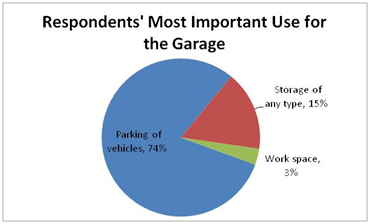Ed Hudson, MBA
April 25, 2013
To Park or Not To Park: The Real Value of Garages (Part 2)
As a successor to the carriage house, everything about our modern residential garage—its size, shape, concrete floor, large entry doors, and location between the driveway and the living area of our homes—point to one primary function … parking for our “modern carriages.” But times change, and with them technologies.
Garage use has certainly changed over time. To find out just how much, the Wall Street Journal commissioned Home Innovation Research Labs earlier this year to conduct a survey of more than 900 homeowners on their attitudes about and uses for the garage. The survey found, somewhat counter-intuitively, that storage was a more common use of the garage than parking. Ninety-three percent of homeowners surveyed use garages for storage while 84 percent use it for parking a vehicle. This isn’t so surprising when you consider another finding of the study – only about 70 percent of garage space in single-family homes is available for parking because the floor space is occupied by something other than a parked car. About half of the respondents cited work space as a use for their garage, and about a quarter reported using the space to work on vehicles or other noisy/messy activities not suited for the house.

But this doesn't mean we should completely overhaul how we view the residential garage. When we asked single-family homeowners the most important function for their garage, the answer was clear and in line with traditional thought. About three-quarters of the respondents chose parking as their garage’s most important function. Storage was of secondary importance, and work space was the top choice by a scant three percent of respondents.

A deeper look into the survey findings showed garage usage patterns differ significantly by household size, age, income, and gender. Single-person households use the garage more for parking (93%) than larger, 3+ person households (77%). Larger households use their garages more often for every other non-parking activity. Higher income households use their garages for parking more than lower-income households. This feeds my suspicion that more people aren’t parking in their garages because the garage space is occupied—by the spillover of storage and activity from the house. Larger households generate more activity and things to store. Lower income households are smaller and have smaller garages—less space for storage and activity in the house and smaller garages that fill up more quickly. The obvious and most prevalent solution already in the market is garage storage systems and outdoor storage buildings. But what is also obvious from this study is that not everyone is taking advantage of these existing options for one reason or another.
Cracking the code on garage usage would be incomplete, however, without considering gender. This study confirms a widespread stereotype that the garage is still primarily a man’s domain. Respondents were asked whether the current ways their garages were used were primarily by men, women, or children. Men were reported to be most likely to work, play, and store their stuff in garages. Men are even slightly more likely to use the garage for parking. Overall, about 70% of all uses were reported to be primarily done by men while 26% were stated to be women (the remaining activities were done by children). One garage activity identified as being done more often by women than men is hosting social gatherings.
So what are the implications on garage design and usage solutions? I've got my theories, particularly based on the responses we got to the question, "How could you best improve your use or enjoyment of your garage?" We asked that of 800 respondents and got almost as many interesting surprises from their answers. I'l touch on these responses and the potential solutions they imply in my next post, the final of this three-part series.
If this summary information has "got your motor running" and you would like to see a complete set of findings from this or other recent Home Innovation surveys, let me know.
Back to Top
Comments
Tina Gleisner
Wednesday, June 29, 2016 9:34 AM